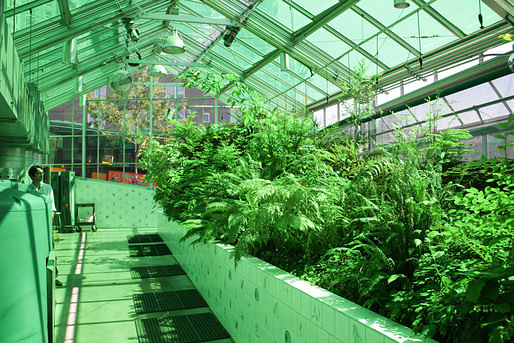
 Tucked into a corner of Seattle's Olympic Sculpture Park, a nondescript glass shed is easily passed by. While the park contains a flashy collection of public art (including a Calder, a Serra, an Oldenburg), the most compelling work here could easily be mistaken for a community greenhouse. Which, in a sense, it is...
Tucked into a corner of Seattle's Olympic Sculpture Park, a nondescript glass shed is easily passed by. While the park contains a flashy collection of public art (including a Calder, a Serra, an Oldenburg), the most compelling work here could easily be mistaken for a community greenhouse. Which, in a sense, it is...
Mark Dion's Neukom Vivarium installation (2006, with Owen Richards Architects) consists of only a few essential elements: the shed tapers boldly from end-to-end but is otherwise fairly banal, with a simply detailed curtain wall. Inside, a 60-foot log lies in a tiled planter bed. Daylight filters through green-tinted skylights. The tiled walls are decorated with illustrations of insects, plants, and animals.

This decomposing trunk is a 'nurse log' kept here in a giant vitrine for observation. In nature, the nurse log is an essential component of the forest ecosystem, especially in the temperate rainforests of the Pacific Northwest (where replenishing natural forest fires are rare). In these forests, cedars, hemlocks, and douglas firs grow to astounding heights: hundreds of feet in some cases. When these trees are felled by strong winds, they lie on the forest floor and take hundreds of years to decompose. The decaying wood acts as a natural sponge, soaking up moisture, and leeching nutrients into the soil. These fallen trunks are soon covered in mosses, lichen, and seedlings, and provide a habitat for insects and small animals. Over time, the next generation of trees grows from this rich matrix, reaching the heights of the forest canopy and completing the cycle.
In the Neukom Vivarium, one such nurse log has been transplanted from the forest to the city. Visitors are encouraged to examine the nascent ecosystem with the provided magnifying glasses, and to cross-reference what they find with the reference material, provided in loose-leaf binders if the illustrated tiles aren't enough of a field guide.
As a didactic tool, the Vivarium certainly serves a purpose, though one wonders if the inevitable school groups would be better served by a trip to a real temperate rainforest (a 2 or 3 hour drive from downtown Seattle). What elevates the work above a field-trip curiosity is the way it elucidates and clarifies the relationship between man and the natural world. For the ecosystem based on the nurse log to survive in this foreign climate (much drier, for instance, than its native environment), it must be supported by climate control, with careful monitoring of heat and humidity levels, lighting conditions, etc. The dappled light passing through the green-tinted skylights feels unusual here in the city, but the hue is in fact close to what you'd see at the rainforest floor.
Thus, what we have here is a fragment of an ecosystem, transplanted from its natural place in the world, and kept alive through mechanical intervention. While this could be interpreted as evidence of domination over the natural world, the subtext becomes clear when viewing the work with a longer timescale in mind. In its native environment, the log would provide sustenance for a new generation of trees, which could grow to hundreds of feet.. here, a height limit is strictly enforced by the enclosure. If trees were allowed to grow and break through the greenhouse roof, it would compromise the carefully-maintained, artificial environment, and the system would likely collapse. Perhaps this is the long-term plan: to demonstrate the fragility of an ecosystem transposed to an 'unnatural' environment, and to show that maintenance of such a system by mechanical means is ultimately a futile endeavor.
Returning to the US after years of work and travel abroad, Evan Chakroff attempts to bring a global perspective to analysis of the relatively-unknown architectural traditions of his new home, Seattle, Washington.... and beyond....
3 Comments
This is a very nice piece of public art. I saw it one year ago but I don't remember the glass being *that* green!
Donna, the green might be a quirk of my camera's auto-white-balance... always tough to get the color right with something this saturated...
Can confirm green-ness, currently closed but if you want to sneak a peek there is a pane of glazing on the uphill end of the Broad street elevation that is translucent enough to see in.
Block this user
Are you sure you want to block this user and hide all related comments throughout the site?
Archinect
This is your first comment on Archinect. Your comment will be visible once approved.